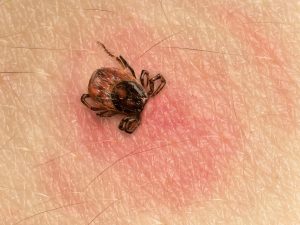 Lyme disease is a bacterial infection that is transmitted by Ixodes ticks, more commonly known as deer ticks. These nymphal ticks are about the size of poppy seeds, yet they carry the dangerous Lyme disease in their bites. Ticks are thought of as insects, but they are actually arachnids that are related to scorpions and spiders. Deer ticks are found all over the United States and in more than 60 other countries. These ticks attach to one’s skin through questing and are able to feed for several days on one host. If left undisturbed, they are more likely to transmit Lyme disease and other pathogens into one’s bloodstream.
Lyme disease is a bacterial infection that is transmitted by Ixodes ticks, more commonly known as deer ticks. These nymphal ticks are about the size of poppy seeds, yet they carry the dangerous Lyme disease in their bites. Ticks are thought of as insects, but they are actually arachnids that are related to scorpions and spiders. Deer ticks are found all over the United States and in more than 60 other countries. These ticks attach to one’s skin through questing and are able to feed for several days on one host. If left undisturbed, they are more likely to transmit Lyme disease and other pathogens into one’s bloodstream.
The Center for Disease Control and Prevention has found that nearly 300,000 people are diagnosed with Lyme disease every year. It’s hard to believe, but that number is 1.5 times the amount of women diagnosed with breast cancer each year. And, that number is actually slightly higher, because many people are misdiagnosed with other similar diseases.
Lyme disease has been called, “The Great Imitator,” because many of the symptoms are confused with conditions like fibromyalgia, multiple sclerosis and many other more common and easier to diagnose diseases. Lyme disease can become very serious if it is not diagnosed early and treated properly. Chronic lyme disease begins to affect organs and cause brain damage, heart problems as well as cognitive issues. It is also very important to recognize symptoms of Lyme disease in small children or women that are pregnant as pregnant women have the ability to pass Lyme disease onto their child. Although it is not common, sometimes this transmission results in a stillbirth.
Because this disease is so similar to other types of conditions, it is important to get all of the facts about symptoms. If you have been outside recently and begin to feel any of these symptoms, it is important that you seek medical attention. You can also use the symptom checker worksheet lymedisease.org has createdto help with your diagnosis.
5 Symptoms of Lyme Disease
-
Fever
Most of the time Lyme disease begins with flu-like symptoms such as fever, chills, sweats, muscle aches, and nausea. If you begin to run a fever after being in wooded areas or after camping, you will want to take over the counter medication, like Tylenol, to lower your fever and be sure to drink plenty of water. If your symptoms do not go away within 72 hours, you will want to assess yourself for the following symptoms as they may be related to Lyme disease.
-
Rash
Most patients who are infected by this disease develop a rash in the shape of a bull’s eye. This rash usually occurs on areas of the body that were not clothed while being outdoors. You may notice an asymmetrical rash on your arms or legs, but a recent study looked at the connection between rashes and Lyme disease and found that about 27-80 percent of people develop a rash when diagnosed with Lyme disease, so this symptom may not apply to every case. If you are suffering from a fever, but cannot find a rash then look for the following symptoms.
-
Joint Pain
Lyme disease tends to cause joint pain and muscle weakness in the knees, elbows, wrists, and shoulders. If you begin to notice a new development of pain in any of your joints, you will want to apply ice to the area and contact your physician.
-
Fatigue
Many people are often misdiagnosed when it comes to Lyme disease because of the reported fatigue. This disease is capable of affecting any organ of the body. But because it can be widespread, symptoms of fatigue are often misdiagnosed as chronic fatigue syndrome and sometimes depression. If you are suffering from a fever, fatigue and a third symptom on this list, get in contact with a medical professional immediately.
-
Bell’s Palsy
As Lyme disease begins to affect other areas of the body it has the potential to affect one’s facial nerves. Bell’s Palsy is a paralysis or weakness in facial muscles on one side of the face. This may cause one’s face to droop and holds the rise of potentially losing sense of taste for anywhere from a few days to weeks.
All of these symptoms are specific to Lyme disease as a whole. When the symptoms come in stages, it is sometimes difficult for physicians to diagnose it. If you experience any symptoms, it is important to monitor your health and seek medical guidance from a physician. If you are pregnant woman and feel that you have one or more of these symptoms of Lyme disease seek help as soon as possible before the disease is passed to the fetus.
Prevention is key in protecting yourself from Lyme disease. Next time you are doing activities outdoors make sure that you are clothed properly and always check the surface of your skin once you return inside following a shower. It is always best to treat early symptoms of Lyme disease with importance. If you suspect you could have this disease, do not hesitate to speak with your physician. If you have any more questions about Lyme disease or ways to relieve joint pain, call Dr. Grossfeld’s office today at 502-212-2663.

Recent Comments